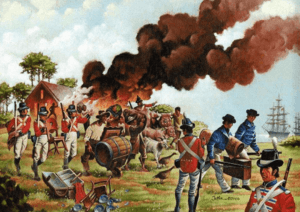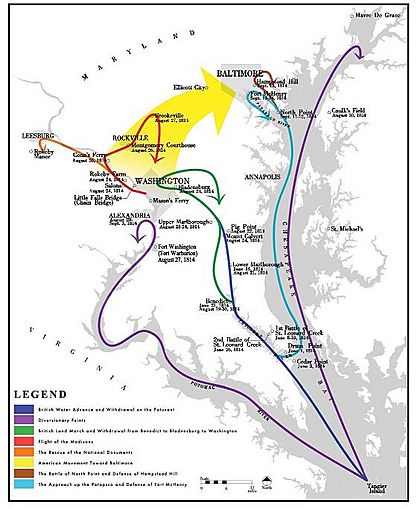Raid on Alexandria (Virginia) facts for kids
Quick facts for kids Raid on Alexandria |
|||||||
|---|---|---|---|---|---|---|---|
| Part of the War of 1812 | |||||||
 During the War of 1812, British naval forces with little American resistance occupied Alexandria, Virginia, then a part of Washington City and for three days plundered at will until they were ordered to withdraw to prepare for the siege of Baltimore three weeks later. |
|||||||
|
|||||||
| Belligerents | |||||||
| Commanders and leaders | |||||||
| James Alexander Gordon | John Rodgers James Monroe Charles Simms |
||||||
| Strength | |||||||
| 6 warships | unknown | ||||||
| Casualties and losses | |||||||
| 7 killed 38 wounded |
11 killed 19 wounded |
||||||
The Raid on Alexandria was a battle during the War of 1812. British forces attacked and took over the city of Alexandria, Virginia. They gained many valuable goods. This event happened in August and September of 1814.
Contents
The Raid on Alexandria
This raid was a success for the British. They got a lot of treasure without losing many soldiers. But it might have helped the Americans later on. The raid caused the British main forces to be delayed. This delay gave the city of Baltimore more time to prepare its defenses.
Why the British Attacked
In the middle of 1814, the British planned a big attack. They sent a naval force into the Chesapeake Bay. Commodore James Alexander Gordon led this group of ships. His orders were to sail up the Potomac River. Their goal was to attack Fort Washington.
This attack was meant to be a distraction. It would draw American soldiers away. The main British attack was on Washington City. General Robert Ross led that attack.
Fort Washington Falls
Fort Washington was the only fort on the Potomac River. It was about 8 miles (13 km) below Washington. The fort had many guns that could fire at ships. But American General William H. Winder was worried. He thought a strong British navy could still get past the fort. If they did, Washington City would be in danger.
A survey from the year before showed problems with the fort. Its main building could only stop musket fire. Even a small cannon could destroy it. The fort had 49 soldiers. They were led by Captain Samuel T. Dyson.
British Ships Advance
Commodore Gordon's fleet had several powerful ships. These included two large frigates, Seahorse and Euryalus. Frigates are fast warships. He also had bomb vessels like Devastation and Aetna. These ships carried large mortars, which are cannons that fire shells high into the air. There was also a rocket vessel called Erebus.
Starting on August 20, Gordon's ships faced a challenge. They spent days navigating shallow waters. Gordon later said his ships got stuck on the bottom twenty times.
Fort Washington Attacked
On August 27, the British bomb vessels began firing at Fort Washington. Captain Dyson was in charge of the fort. General Winder had told him to destroy the fort only if British troops attacked from behind. Winder also sent about 500 militia soldiers to help defend the fort. Militia are citizen soldiers.
However, after two hours of bombing, Captain Dyson made a decision. He disabled his own guns and blew up the fort. The fort's storage area had 3,000 pounds (1,360 kg) of gunpowder. Dyson and his men then left the fort.
After this, Captain Dyson was removed from his command. He was put under house arrest. A military trial found him guilty. He was found guilty of leaving his post and destroying government property. He was then removed from the army.
Gordon later wrote about the attack. He said his ships anchored just out of gun range. The bomb vessels started firing shells. To their surprise, the American soldiers left the fort. Soon after, Fort Washington exploded.
Alexandria Surrenders
With Fort Washington gone, nothing stopped the British ships. They could easily reach Alexandria. This was a rich port city just a few miles upriver. The city's leaders had already tried to surrender to another British admiral.
On the morning of August 28, the Mayor of Alexandria, Charles Simms, went to meet Gordon. He carried a white flag, showing he wanted to surrender. Since it was Sunday, Gordon told the Mayor to go back to Alexandria. He said his ships would arrive on Monday.
British Take Over
On August 29, the British ships lined up along the town. They could fire on any part of Alexandria. The ships were very close to the docks and houses. They could have destroyed the town in minutes.
To save their city, Alexandria's leaders agreed to British demands. They handed over all merchant ships. This included ships that had been sunk on purpose to keep them from being captured. They also gave up huge amounts of goods. The British took 22 merchant ships. They also took flour, cotton, tobacco, wines, and cigars.
The British ships were delayed by the shallow Potomac River. So, Gordon's fleet arrived almost a week after other British troops had already burned parts of Washington City. Gordon decided not to go further upriver. He had achieved his main goal of silencing Fort Washington. His presence in Alexandria still caused problems for the American government. The government was trying to get back to normal after the attack on Washington.
British Leave Alexandria
After three days in Alexandria, Gordon received new orders. A British ship called Fairy arrived. It told Gordon to rejoin the main British fleet. This fleet was in the Chesapeake Bay.
Gordon began to leave in stages. On September 1, he sent two ships ahead. The rest of the ships left Alexandria on September 2. But they met American militia batteries on the shore. These were groups of cannons.
Commodore John Rodgers tried to attack Gordon's ships. He used crews from two American frigates that were being built. He tried twice to send "fireships" against the British. Fireships are old ships set on fire and sent to burn enemy ships. But British sailors stopped both attempts.
On August 31, Secretary of State James Monroe gave an order. He was acting as the Secretary of War at the time. He ordered an American artillery battery to be quickly built. This was on the Virginia shore, near what is now Fort Belvoir.
Bad winds kept the British ships from passing this battery. But the winds changed on September 5. Gordon had his sailors shift heavy weights in the ships. This made the ships lean to one side. It allowed their cannons to fire higher. After a strong attack, the British fleet passed the battery in about an hour.
Aftermath of the Raid
Gordon rejoined the main British fleet on September 9. The raid on Alexandria was very successful for the British in terms of money and goods. However, the delays on the Potomac River were important. They stopped Gordon from helping the attack on Washington City.
The British commander, Vice Admiral Alexander Cochrane, had to wait for Gordon. He waited partly in case Gordon needed help. Also, Gordon's fleet had most of the bomb vessels and rocket ships. This waiting period was key. It gave the defenders of Baltimore more time to strengthen their defenses. This extra time helped them successfully fight off the British attack on Baltimore.


